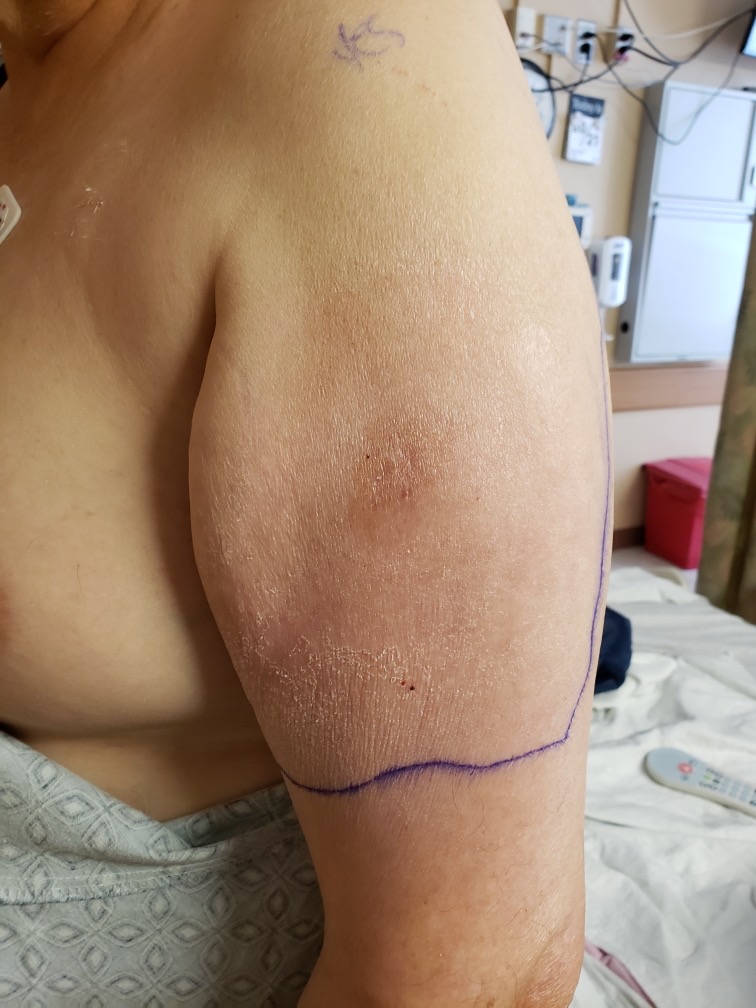Case Presentation: A 69 year old male with past medical history of hypertension and lumbar spinal stenosis presented with numbness of the first and second digits of the left hand that progressed to weak grasp over the previous 24 hours. On arrival, vital signs were normal. Exam was significant for a well appearing male in mild anxious distress, weak grip strength on the left compared to right, with no other focal neurologic symptoms. The remainder of the exam was unremarkable. Stroke workup was pursued with a CT angiogram of the brain and neck, and MRI of the brain. No acute findings were identified. Complete blood count, basic metabolic panel, urinalysis, urine toxicology, and EKG were all normal. Overnight, the patient’s weakness progressed to the point he could not move his left upper extremity, and he complained of severe pain in the arm as well. Repeat exam was remarkable for 2/5 strength in a distribution consistent with the posterior cord of the brachial plexus, and numbness in the musculocutaneous distribution. An area of faint erythema, in an oval shape, 7cm x 4cm, was noted over the lateral aspect of the arm. Further history revealed an insect bite 4 weeks prior, which did have an associated rash that had been treated with a 5-day course of cephalexin without significant improvement. Lyme reflex testing had been sent at that time and was negative. The patient adamantly denied tick exposure. As it was summer in Rhode Island, lyme neuropathy was nevertheless suspected, and the patient was empirically started on IV doxycycline. MRI of the cervical spine was pursued to rule out a cervical spinal cause of the patient’s weakness, which it did. EKG did not show evidence of heart block. Lyme reflex studies were again sent and were positive, western blot confirmed lyme disease. Infectious disease was consulted who recommended a 28 day course of ceftriaxone. The patient was also started on a 12-day prednisone taper. His weakness resolved within 2 weeks. Four months later, intermittent paresthesias persist.
Discussion: Lyme disease is a tick-borne infection named for the area in which it was first discovered in the United States: Lyme, Connecticut. It is caused by a spirochete of the Borrelia species and transmitted by the Ixodes tick. The categorization of Lyme disease can be confusing. First it is divided into local or disseminated disease. Disseminated disease is further categorized into early and late phases. Local disease refers to the acute, local, erythema migrans rash. The rash is thought to represent migration of the spirochete away from the site of inoculation, leaving a central clearing and the characteristic targetoid appearance. Cardiac, joint and neurologic involvement occur in disseminated disease. Neurologic symptoms, as in this case, can appear at any time in disseminated disease and can involve the central or peripheral nervous system, or both. Neurologic involvement is termed Lyme neuroborreliosis (LNB). LNB treatment is guided by the American Academy of Neurology who recommend intravenous penicillin, ceftriaxone or cefotaxime. Ten to fourteen days of therapy may be sufficient, but 28 days is often used in cases with central nervous system involvement.
Conclusions: Lyme disease is the most common tick borne illness in the United States. The clinical presentation is variable and the naming system is complex, making the diagnosis difficult. Hospitalists should consider Lyme disease as part of the differential diagnosis in endemic areas and in patients with recent travel to endemic areas, particularly in the summer months.

